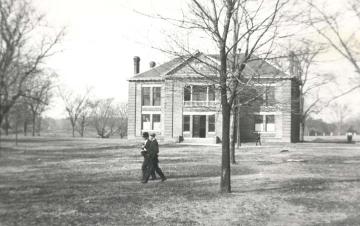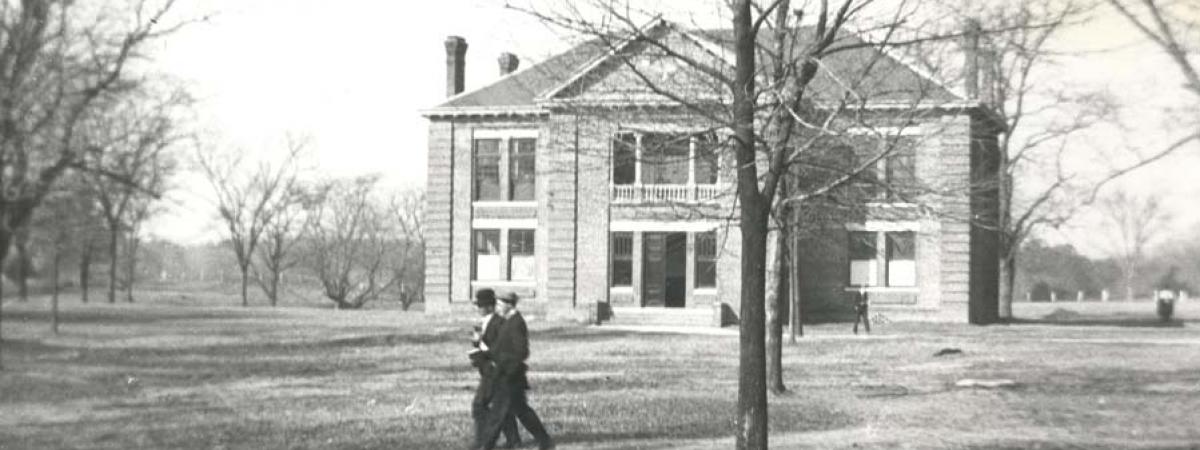
Year built 1900
Opened: November 1900
Renamed: Citizenship Hall in 1922
Demolished: 1931
Map it for me
Note: Location on map is approximate.
The Old Gymnasium at William & Mary was located southwest of the Wren Building, in line with the west end of the chapel side of the building, and 100 feet from the chapel. It opened in 1900 and was demolished in 1931. It served as William & Mary's first gym and was replaced as the home of William & Mary athletics in the 1920s by Jefferson Hall and Blow Gym.
In 1888, newly appointed President Lyon G. Tyler ordered $50 be applied to the erection of a gymnasium. At a June 1892 meeting of the Board of Visitors, Tyler again recommended that "A pavilion should be erected for a modest gymnasium near the college building," later saying that "a well equipped institution speaks to the senses of men and can be seen, felt and appreciated. The public gets the impression that the men who look to appearance are wide awake men." In 1896, the Board of Visitors appointed a committee to raise the funds necessary for construction. Richard Y. Cook of Philadelphia offered to donate $1,000 for equipment and architect Marion J. Dimmock of Richmond, Virginia, offered to prepare plans and specifications for the building.
The building was originally intended as a memorial to Tazewell Taylor, as mentioned in a letter from Richard Y. Cook to the fundraising committee in March 1897. When Mrs. Taylor, Tazewell's mother, objected to the use of her donation for an athletics facility instead of renovating the Wren Chapel, Robert M. Hughes proposed a plan to President Tyler that involved renovating the chapel to include a gym on the second floor. Although Hughes was determined to follow through with his plan, President Tyler was not optimistic.
Eventually, in June 1899, the Board of Visitors decided that as soon as they raised $3600 that construction should start on the Tazewell Taylor building, "to be located as an annex to the physical laboratory wing of the College building (Wren) but separated therefrom by a fire proof wall." The fundraising committee was then empowered to hire an architect and contract work, with the building cost not to exceed $5,300. According to a fundraising letter sent out by Hughes on August 15, 1898, "The family of the late Tazewell Taylor, of Norfolk, made a large contribution on condition that it should be called "The Tazewell Taylor Gymnasium." Marion J. Dimmock's plans were accepted in 1900 and the committee awarded the construction contract to W.H. Sweaney of Williamsburg for $6074. Work was to be completed by November 1, 1900.
There was a YMCA club room in the gym in 1917 and an armory for the Students' Army Training Corps, which was on campus during World War I in 1918. The gym turned into a lecture room building in 1922 and was used by the School of Business Administration, the Marshall-Wythe School of Government and Citizenship, and the School of Journalism. Six classrooms, professors' offices, the Law School, and the Law Library were also part of the building in 1923. The Law Library was transferred to new stacks in the College Library (the current Tucker Hall) in 1929. Citizenship "A" was converted to a post office in 1929, employing students instead of Federal Post Office employees. The post office was large enough for packages and served both men's and women's dormitories, replacing the former dormitory post office system. The U.S. Government intended to establish an official Post Office in the Citizenship Building in October 1929, but this was delayed until January 1, 1930.
The Flat Hat offices moved into rooms in 1929 (Citizenship Number Two) and the business department occupied the old editorial and news office. Station A, the College Post Office, was set to be discontinued on December 31, 1930, and students started receiving their mail from the city Post Office.
The gymnasium was demolished in 1931.
Board of Visitors Excerpts
June 1892
"A pavilion should be erected for a modest gymnasium near the College building. I make these recommendations with all the more earnestness for the reason that at the meeting of the Executive Committee which met in Richmond 10 December 1891 when Gen. Taliaferro, Walter Edwards, J.N. Stubbs, D.G. Tyler, T.H. Barnes, Dr. E.G. Booth and P.M. Thompson were present. I read a paper which was endorsed by a formal resolution of the Faculty and was drawed up by me at their request in which a Hall, Gymnasium and increased accommodations were made one of the reasons for an appropriation from the Legislature. And I may say that in the speech of our worthy President of the Board before the House Committee he took a wide range of argument, not convincing himself as I understood him."
April 18, 1893
"A building could be erected at an expense not exceeding $3,000.00 which would serve the purposes of a hall and gymnasium both. It need not be of brick, a plain, tastefully planned frame building with a single room would answer.
"If the gymnasium is determined on, then it becomes necessary to employ a Teacher for the purpose of taking control. I would oppose a gymnasium otherwise, as the students without control would either break up all the apparatus or exercise without any regularity and probably injure themselves by over exercise. At all other institutions a library fee is charged and I do not see why it would militate against this College to charge a similar fee.
"I refer to the letter of Mr. Willoughby Reed for further information on this subject. I am sure that $12000. would cover all these improvements and leave an ample sum behind to be added to the regular endowment. I sincerely believe that an investment in of a portion of the funds in real estate improvements would be of more value to the College in any contingency than the interest on the money. It would attract public attention greater than anything else. A well equipped institution speaks to the senses of men and can be seen, felt and appreciated. The public gets the impression that the men who look to appearance are wide awake men. I have known property once again in value by the application to the buildings of a trifling amount of paint or carpenter work."
June 1, 1898
"Physical culture has secured a strong position in the schools, and William & Mary though in years the oldest College, is in its system of instruction to the youngest should, if possible, lack no feature to put it alongside the best Normal Schools in the Country. I believe a good gymnasium would be a great attraction to the College. It would increase the attendance besides improving the general conditions of the Institution. Two years ago a committee was appointed consisting of Messrs. Hughes, Cary and Mumford to take the necessary steps towards receiving the other necessary funds. I am not informed as to the result, but the well known interest which these gentlemen have taken in the Institution makes it perfectly evident that all has been done in the interim which could have been done."
June 21, 1899
"Where upon Mr. Mumford offered the following substitute, which was adopted.
"Resolved. That the President of this College be authorized and directed to procure from one or more competent architects, plans and specifications for the erection of a building to be known as the Tazewell Taylor Building, which building shall be so planned as to furnish, if possible, adequate room for a gymnasium and a hall for the use of the Y.M.C.A of the College. The plans, so to be furnished, shall show in detail the sized, general appearance, and interior arrangement of the building. Which, shall conform in general architectural features to the present buildings upon the campus.
"Said architect or architects shall also indicate in what position said building should be most appropriately located. Together with such suggestions with respect to the size, character and architectural features of the building as in his opinion it would be well to construct at a cost not exceeding $5300.00. To defray the expense of procuring the aforesaid plans and specifications, the said President of the College is authorized to expend out of the money contributed for the erection of said building, a sum not exceeding $300.
"As soon as said plans and specifications shall have been attained, the President of the Board of Visitors shall call a meeting of the Board who shall take such action in reference to the matter as they may deem proper."
June 6, 1905
"I am sorry to announce the resignation of the Rev. Mr. King, the Physical Director, as I am sure the Board will have difficulty in supplying his place. The work of the gymnasium has been a great addition to our College work and was made by the Faculty a part of the Normal course. Its value consisted in reaching all classes of our students, which no field work can possibly do. By its salutary influences many of our weaker students unfit for service or base ball and foot ball teams have been built up and quality improved in their general health and physical condition. I voice the wish of the Faculty that the Board in making a new selection will see that this leading feature of the College is sustained, that a competent person in gymnasium work be selected as Mr. King's successor and that the work in the gymnasium be made continuous throughout the session."
June 8, 1911
"In placing the pipes of the new Power Plant in the College buildings it has been found that the joints supporting the flow of the Gymnasium and the floor of the first story of the Manual Art Department are decayed and must be removed."
January 7, 1916
"On motion it was
Resolved, to ask the Legislature
for the following; Increase of Annuity $10000.00
New Dormitory and Equipment 50000.00
Addition to Science Hall 12000.00
" " Gymnasium 4000.00
Total $76000.00
And a committee composed of the Rector of the Board, President of the College and Chairman of the Finance Committee were selected to obtain the services of an Architect to make drawings and estimates of the cost of a dormitory and were instructed to appear before the Legislature and urge the passage of the above accounts as the urgent needs of the College."
January 7, 1922
"We respectfully request that you authorize that the old gymnasium be made into lecture rooms at a cost not to exceed $3,000."
Photographs
- Colonial Echo: 1901 p. 69; 1906 p. 72; 1907 p. 112; 1909 p. 126.
- 1905-Catalog, p. 40
- Taps, p. 29; interior, p. 9, 23
Material in the Special Collections Research Center
- Colonial Echo
- The Flat Hat
- Board of Visitors Records, Special Collections Research Center, Earl Gregg Swem Library, The College of William & Mary.
- Office of the President Records, Special Collections Research Center, Earl Gregg Swem Library, The College of William & Mary.
- University Archives Subject File Collection, Special Collections Research Center, Earl Gregg Swem Library, The College of William & Mary.
- Robert M. Hughes Papers, Special Collections Research Center, Earl Gregg Swem Library, The College of William & Mary.
External Links
- The Open Forum: Suggest leave hall standing, The Flat Hat, 11/2/1928, p. 5.
- The Open Forum: Worry over condition of Citizenship Building, The Flat Hat, 1/18/1929, p. 4.
- Flat Hat moves into new quarters, The Flat Hat, 10/4/1929, p. 12.

